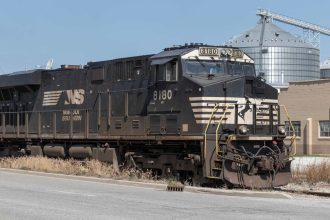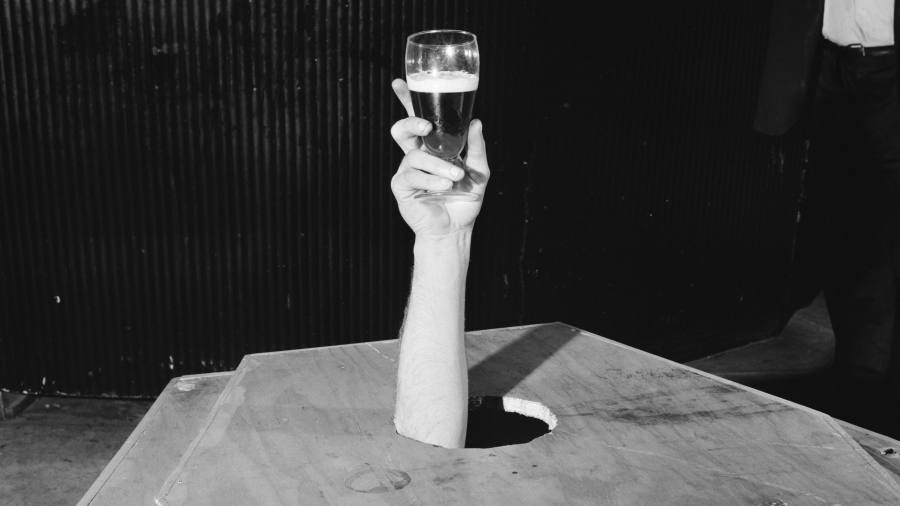I am on my fourth pint of the night and I feel fantastic. The atmosphere has, after simmering away with a post-work propriety, jolted alive with that inimitable spark of possibility that comes when an entire room of the tipsy and the timid finally drop their guard.
On the table to my left, three hop-bellied geezers are attempting to discuss Arsenal’s chances of success, but are becoming increasingly, hopelessly distracted by the volume of the chart-centric jukebox. An old boy on a mobility scooter nurses a Guinness and looks around curiously.
At the table to my right, a young man in an electrician’s uniform sticks a hand in the air, locks eyes with me and, just as he’s been doing for the past three songs, raps along with me: “I’m Slim Shady, yes, I’m the real Shady / All you other Slim Shadys are just imitating / So won’t the real Slim Shady, please stand up?”
Welcome to north London’s The Tarmon on a Friday night, the type of bacchanalian, absurdist boozer full of warmth, wit and mild jeopardy that is gradually disappearing from the capital’s nightlife scene. I’ve been coming to this pub at the southern end of Caledonian Road for the past two and a half years, ever since I discovered that pints here were £3.50. Yes, that’s not a typo: three English pounds and 50 pence for a pint of Birra Moretti. In Zone 2.
On long Saturday afternoons spent deep in refreshment, friends used to shelling out over a fiver for a continental lager would marvel in amazement. “What’s their secret, Jimmy?” they’d ask me. “How can they charge so little compared with everywhere else in London?”
And it’s true, the price you’re usually paying today for a full measure of amber nectar in the capital is untenably high. According to the Evening Standard, the average price of a pint of lager — the sine qua non of British pub culture — reached more than £6 in some boroughs in 2022. That dropped only slightly to £5.19 in Islington. The craft connoisseurs at the Campaign for Real Ale have the nationwide average at £3.95 for the same year.
It didn’t used to be like this. When compared with those halcyon, pre-smoking-ban days of 2000, the price of a lager has gone up by a liver-wrenching 94 per cent. This has hit wet-led pubs — ones that, like The Tarmon, serve no food beyond your usual Nobby’s Nuts or pork scratchings — the hardest. The British Beer & Pub Association (BBPA) told me that in the year from March 2022 to March 2023, the number of wet-leds declined by 3.1 per cent, as opposed to food-focused taverns, whose number dwindled by 2.2 per cent.
For the past two years, I’ve been documenting the closed or demolished pubs of London on Instagram. There was The Favourite in Holland Park, a flat-roof community pub that was sold for about £2mn in 2012 and subsequently razed for student flats. There was The Lillie Langtry, the last inn on Abbey Road, which closed in 2022 and is due to be pulled down along with the neighbouring estate. I plot these ghost pubs on a map and plan running routes across the city that take me past them. What I find standing in their place is often depressing: an uninspiring, cubiform block of flats here, a Local or a Metro or an Express there.
The Dead Pubs project also made me realise the extent to which a pub like The Tarmon is an anomaly among inner London pubs, with their Aperol Spritzes and £20 roast dinners. But they do still exist, albeit in dwindling numbers. I had the vague plan of trying to uncover how the ones that remain manage to hold on, which is how, ultimately, I found myself rapping along to Eminem’s greatest hits at 10.30pm on a Friday night.
First I had to line my stomach, and get a glimpse of life at the other end of the pub spectrum. Five hundred metres from The Tarmon, down the other end of Richmond Avenue, lies The Albion, a grand gastropub where pints range from £6 to a whopping £7.50 for an Estrella Damm. It’s a lovely looking tavern in the middle of Barnsbury, the original gentrified inner London suburb, and has always had something of a country pub feel to it, that rus in urbe creeping through in its generous garden and roaring fireplaces. Today, it’s part of the Noble Inns family, a small hospitality group that owns three other pseudo-pubs in north London, each offering diners a chance to tuck into the finest in seasonal British produce while sitting in some of the most uncomfortable high-backed wooden chairs around.
The first thing that strikes you when you enter The Albion is the sheer number of people. At 9pm, it’s absolutely rammed with first dates, old friends and work colleagues, nattering away over bottles of wine and pints of craft beer. The second thing is the smell. That unmistakable, deeply savoury nidor of cooked beef and carbs. I’ve been to a lot of gastropubs in my drinking career. Some stay true to the pub portion of their name, with ordering at the bar and a casual dining experience pushed to the fore. The Albion goes the other way.
Serving food in pubs is a contentious point among the pint community. There are old souls who believe that even the merest morsel of toastie should be banished from the threshold of any respectable hostelry. But there’s a reason so many pubs serve food. According to a 2022 BBPA guide (based on data from 2021, pre-energy crisis), a small pub with no food bringing in £4,000 a week would be left with just £580 in divisible balance (the net profit shared between tenant and landlord) after its outgoings — alcohol, wages, Sky TV — are accounted for. Have a bad month and you’re losing money. For gastropubs, it’s different. For a “Town/Country Food-Led” pub where the split of drink to food is 30:70, a turnover of £15,000 a week would mean a weekly divisible balance of just over £2,500. The outgoings are higher, but so are the rewards. Noble Inns declined to answer my questions about their pricing.
Sated by an £18 beef burger and weary of the ambient wash of polite chatter, it was time to move down the road to The Tarmon and let the bibulous festivities begin. “Tarmon” comes from “Termon’’ which comes from the Irish tearmann, meaning “refuge” or “sanctuary”, and the pub certainly acts as that today, with its revolving cast of Arsenal fans, local sesh-heads and impoverished students regularly propping up its bar. An ornate, pilastered and pedimented three-storey corner pub dating back to the 1850s, the building managed to survive the bombings of the second world war which destroyed much of the surrounding area. But it’s spartan inside now, long since stripped of its original carpet and seating. The horseshoe bar has Perspex protection screens that have somehow survived the pandemic. The regular Friday barmaid is one of the best I’ve ever encountered; partly due to her excellent Guinness pour, and partly due to the fact she refers to me as “the movie star”, after I once wore a two-piece suit to the pub. As I waited for my first drink, I asked her how they can keep their prices so low, especially as they don’t serve any food.
“Well, of course, we’ve just got a good deal haven’t we,” she said. She suggested I’d be better off speaking to the owner: Andrew Panayi, a controversial property tycoon who owns much of this end of Caledonian Road and who has in the past had a reputation for stretching (and in one case surpassing) the limits of legality when it comes to residential lettings. (In a 2015 Commons debate of the Housing and Planning Bill, Panayi was described by MP Gareth Thomas as “an example of the worst landlords in London”.)
The barmaid said I was welcome to visit him at his offices which, conveniently, sit immediately over the road from the pub. I ordered a Tequila Rose, sat back down, and the night passed by in a blur of noughties rap and football chat.
The following week, I paid Panayi a visit. I was determined to find out how the last good pub in London could keep its prices so low, especially when it never really seemed to get that busy. His offices are in an ex-antique shop and, as I pressed the doorbell, I became conscious of the number of cameras outside. After what felt like five minutes, I was buzzed in and descended the narrow stairs into a glass-fronted reception, where I explained that I was writing for the Financial Times, and was wondering if anyone could answer some questions about The Tarmon. I could see Panayi tucking into lunch in the back room, which looked startlingly like the back office of the Bada Bing from The Sopranos — all low-level lighting, leather sofas and beige Bisley filing cabinets. A young assistant seemed taken aback by my request and, after a few uncertain glances, said that if I came back in an hour, I could speak to Panayi.
When I returned, the hesitant assistant had been replaced by a stern-looking woman. “Yeah, sorry, Andrew’s not in today. And even if he was, there’s nothing he could tell you. He doesn’t speak to journalists.” Eventually, she conceded. “All I can say is that Andrew loves this road and loves the people that run the pub, so he gives them a good deal.” With that, I was ushered up the stairs and back out on to the Caledonian Road.
I had been on my Barnsbury odyssey. I’d dropped north of £80 on food and booze and given myself two days’ worth of crippling nausea in the process. But all I had to show for it was an awkward rapport with the best barmaid in north London. I decided to consult my dead pub archives, and to put the call out to some ex-London publicans and enthusiasts, to see if they could give me a view on the state of the industry, free from the suspicion that I was going to accuse them of fiddling the books.
The Admiral Mann, a cosy, carpeted affair on the Camden side of Brecknock Road, closed suddenly in 2014 after the owners, the McMullen’s brewery, announced that they had sold the building off to property developers. A passionate campaign to save the pub was successful in listing it as an asset of community value (ACV) and blocking attempts by the developers to gain planning permission, but the building remains in a state of limbo: it can’t be converted into flats, nor does it seem likely that anyone will buy it back and reopen it as a boozer.
Richard Lewis, a regular at The Admiral Mann, was part of the campaign to save the pub, which he claims was making a healthy profit. “The reality is you could have people queueing around the block buying endless pints all day and it still wouldn’t make as much money as a sale to developers,” Lewis said over email. McMullen’s declined to comment after I contacted them.
Joseph Ryan and his partner Holly Murdoch run The Seadog in Hastings, a charming beer-lovers pub in the centre of town that opened in early 2022. Prior to Ryan’s south-coast switch, he was in charge of three London institutions, each of which were forced to shut their doors: The Fox in Haggerston and The Bear in Camberwell, two wet-led boozers, and The White Hart in New Cross. All three were leased from The Wellington Pub Group, and all three closed in similar circumstances, as Ryan explained to me: “Instead of renewing the leases, we were asked to leave so redevelopment could take place. They insisted the pubs couldn’t operate while construction was taking place, and added stringent clauses on how they should operate once the lease was available again.” These clauses were things that made it “near impossible for a pub business to function”, like having the venue completely empty by 11pm (meaning last orders at 10.30pm — early, even for London), and not having any music.
When I contacted them, Roger Thornton of The Wellington Pub Group said, “Wellington reviews its portfolio regularly to optimise value and as such chose not to renew the leases mentioned at expiry. The redevelopment works to the upper parts of these properties necessitated the pub being closed during the project to allow access for contractors, welfare and safety.” The Fox and The White Hart have been sitting dormant ever since, although The Bear recently reopened under new management.
Wet-led pubs exist in a curious bubble. Most of those that are left are, due to their smaller size, just about surviving, although many of them would never make a Time Out list of best pubs. If they started serving food and appealing to a wider audience, their overheads would increase at a time when energy and goods prices are at a high.
They’re a strange relic of the past, these places, a time when pubs were the centre of a community used to spending most nights socialising with a drink. And in a London where everything has a price, these Stella sanctuaries are an easy target for developers. The Tarmon is a clinger-on — a pub that owes its existence, as far as I could learn, to the benevolence of a landlord who has maximised profits elsewhere.
A few weeks after my fruitless journey, I head back to The Tarmon one wet Wednesday evening. Past the Hemingford, a handsome, ivy-covered pub that serves Thai food. Past The Tamil Prince, a South Indian restaurant-cum-pub once known as The Huntingdon Arms. I fumble The Tarmon’s door — it’s not locked, is it? No, I’m pulling instead of pushing. I walk in. The barmaid grins and greets me like an old friend: “Hello movie star, what can I get you?” I order a pint of Moretti, and sit down in the corner near the men’s toilets.
Manchester City are playing Leipzig in the Champions League on mute, but no one’s really paying attention. A middle-aged woman gets up, walks over to the jukebox and drops a few coins in. The night begins to sizzle with possibility.
Jimmy McIntosh charts the closed or demolished pubs of London on Instagram at londondeadpubs
Read the full article here





